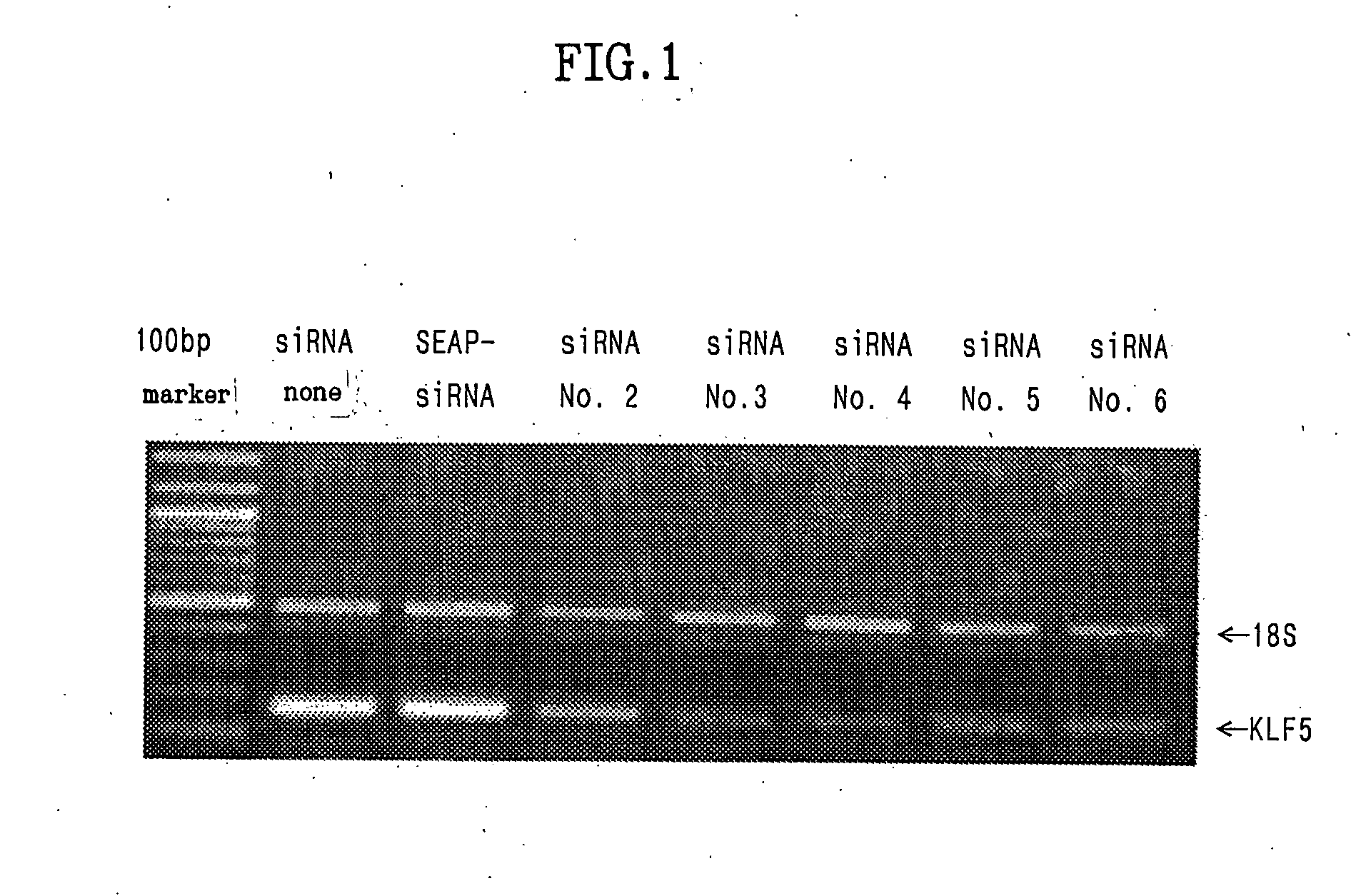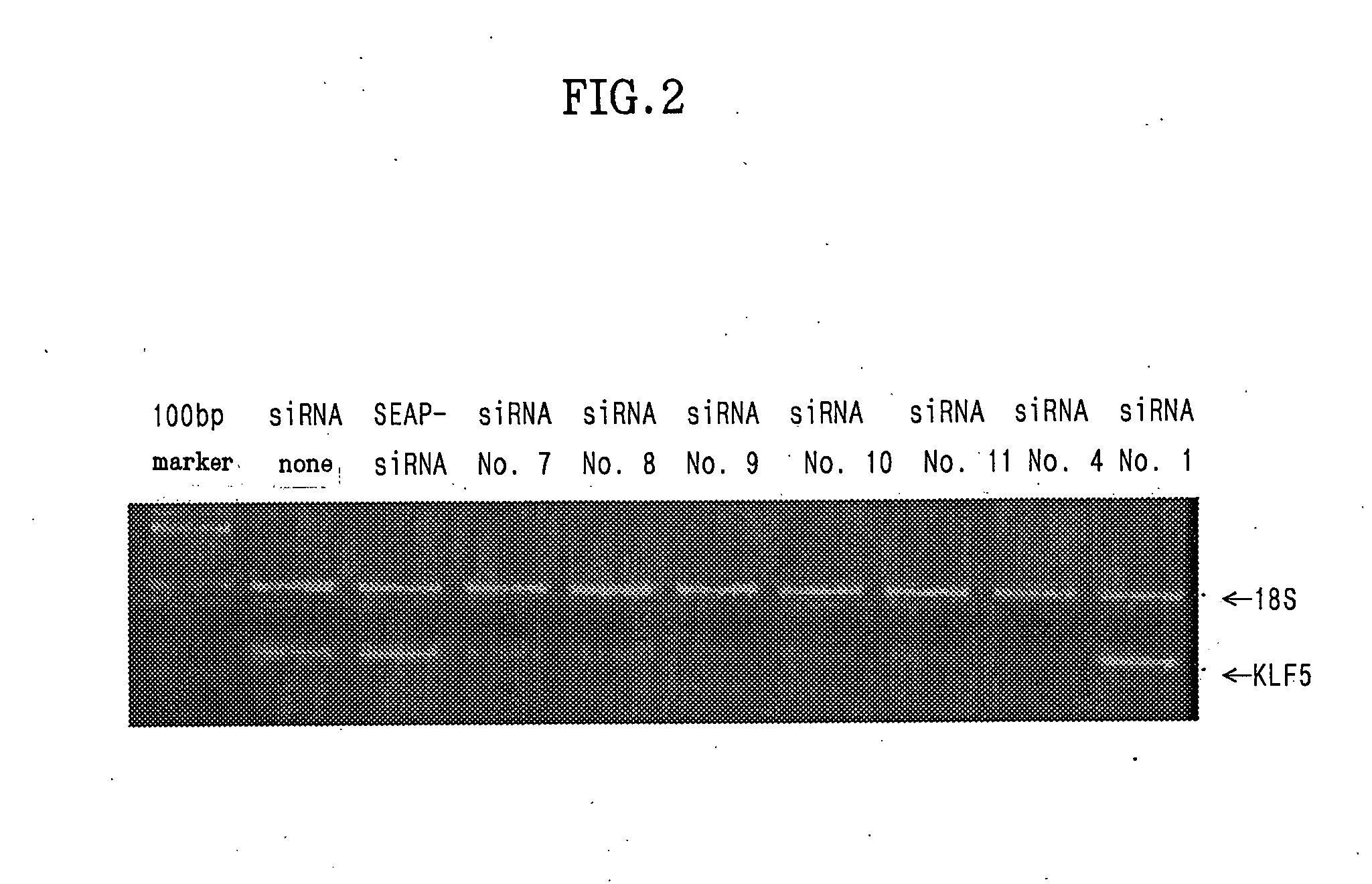Rna Capable of Suppressing Expression of Klf5 Gene
a technology of klf5 and sirna, which is applied in the field of rna, can solve the problems of inability to suppress a specific gene, unknown drugs for effectively suppressing the expression of klf family genes, and inability to report rnai using klf5 or other klf family genes to date, and achieves the effect of inhibiting the growth of smooth muscle or angiogenesis
- Summary
- Abstract
- Description
- Claims
- Application Information
AI Technical Summary
Benefits of technology
Problems solved by technology
Method used
Image
Examples
example 1
Suppression of the Expression of KLF5 Gene by siRNA
(1) Preparation of siRNA
[0068] As the sequence of siRNA which can suppress expression of KLF5 gene, from the sequence of mouse KLF5 cDNA (GenBank Registration No. NM—009769; SEQ ID NO: 49), 11 sequence portions that satisfy the following 2 requirements were selected: (a) a sequence consisting of 21 nucleotides that begin with AA; and (b) a GC content between 20% and 80%. Such sequence portions were preferably selected from sequence portions, which are located in a coding region (the sequence portion at nucleotides 167-1507 of SEQ ID NO: 49) and further located 75 nucleotides or more downstream of a start codon (the sequence portion at nucleotides 167-169 of SEQ ID NO: 49), and which have a GC content between 40% and 60%. The positions of the selected sequences in SEQ ID NO: 49 and GC contents thereof are shown in Table 1. Sequences obtained by substituting T with U in 19 nucleotides excluding AA at the 5′-terminus thereof in the ...
example 2
Suppression of the Expression of Genes Whose Transcription is Activated by KLF5, by KLF5 Gene-Specific siRNA
(1) Suppression of the Expression of PDGF-A Gene
[0075] As KLF5 gene-specific siRNA, each of siRNA No. 1, No. 4, No. 7, No. 8, No. 9, No. 10, and No. 11, was transfected into C3H / 10T1 / 2 cells. Thereafter, the expression of PDGF-A gene whose transcription is activated by KLF5 was analyzed by RT-PCR.
[0076] Each siRNA was transfected into C3H / 10T1 / 2 cells and cDNA was then prepared in the same manner as in Example 1(2). Two DNAs each having the sequence shown in SEQ ID NO: 43 or 44 were chemically synthesized. These DNAs were used as PDGF-A gene-specific forward primer and reverse primer. By carrying out PCR using these primers, a 403-bp fragment is amplified from PDGF-A cDNA. The PDGF-A gene-specific forward primer and reverse primer were used instead of the KLF5 gene-specific forward primer and reverse primer, and the expression of PDGF-A gene was analyzed in the same manner...
example 3
Suppression of the Expression of Human KLF5 Gene by siRNA
[0084] The siRNA No. 4 prepared in Example 1 is siRNA produced based on the sequence (AAAAGCTCACCTGAGGACTCA) at nucleotides 1303 to 1323 of the nucleotide sequence (SEQ ID NO: 49) of mouse KLF5 cDNA. The siRNA No. 4 strongly suppressed the expression of mouse KLF5 gene in C3H / 10T1 / 2 cells. However, this sequence, AAAAGCTCACCTGAGGACTCA, also exists at nucleotides 1481 to 1501 of the nucleotide sequence (SEQ ID NO: 50) of human KLF5 cDNA. Thus, it is anticipated that siRNA No. 4 inhibit not only the expression of mouse KLF5 gene but also that of human KLF5 gene. As described below, it was confirmed that siRNA No. 4 strongly suppressed the expression of human KLF5 gene.
[0085] Human umbilical cord venous endothelial cells (HUVEC; procured from Sanko Junyaku Co., Ltd.; Production No. CC-2517) were inoculated into a 6-cm dish (Corning), resulting in a concentration of approximately 3×105 cells. 10 μl of a cell transfection reagent...
PUM
 Login to View More
Login to View More Abstract
Description
Claims
Application Information
 Login to View More
Login to View More - R&D
- Intellectual Property
- Life Sciences
- Materials
- Tech Scout
- Unparalleled Data Quality
- Higher Quality Content
- 60% Fewer Hallucinations
Browse by: Latest US Patents, China's latest patents, Technical Efficacy Thesaurus, Application Domain, Technology Topic, Popular Technical Reports.
© 2025 PatSnap. All rights reserved.Legal|Privacy policy|Modern Slavery Act Transparency Statement|Sitemap|About US| Contact US: help@patsnap.com



